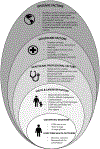ROUTE-T1D: A behavioral intervention to promote optimal continuous glucose monitor use among racially minoritized youth with type 1 diabetes: Design and development
- PMID: 38460913
- PMCID: PMC11065587
- DOI: 10.1016/j.cct.2024.107493
ROUTE-T1D: A behavioral intervention to promote optimal continuous glucose monitor use among racially minoritized youth with type 1 diabetes: Design and development
Abstract
Background: Type 1 diabetes management is often challenging during adolescence, and many youth with type 1 diabetes struggle with sustained and optimal continuous glucose monitor (CGM) use. Due to racial oppression and racially discriminatory policies leading to inequitable access to quality healthcare and life necessities, racially minoritized youth are significantly less likely to use CGM.
Methods: ROUTE-T1D: Research on Optimizing the Use of Technology with Education is a pilot behavioral intervention designed to promote optimal CGM use among racially minoritized youth with type 1 diabetes. Intervention strategies include problem solving CGM challenges and promoting positive caregiver-youth communication related to CGM data.
Results: This randomized waitlist intervention provides participants with access to three telemedicine sessions with a Certified Diabetes Care and Education Specialist. Caregiver participants are also connected with a peer-parent coach.
Conclusion: Hypothesized findings and anticipated challenges are discussed. Future directions regarding sustaining and optimizing the use of diabetes technology among racially minoritized pediatric populations are reviewed.
Keywords: Behavioral intervention; Continuous glucose monitor; Diabetes.
Copyright © 2024 Elsevier Inc. All rights reserved.
Conflict of interest statement
Declaration of competing interest The authors declare the following financial interests/personal relationships which may be considered as potential competing interests: M.M. is currently employed by the National Institute of Diabetes and Digestive and Kidney Diseases, National Institutes of Health (NIDDK/NIH). B.E.M. is supported by the National Institutes of Health (PI: Marks, NIH: K23DK129827), and has received investigator-initiated research support from Tandem Diabetes Care, Inc. (TDC20210226), and the Cystic Fibrosis Foundation, industry sponsored research support from Medtronic, and research supplies from Dexcom, Inc. and Digostics.
Figures


Similar articles
-
A cognitive behavioral therapy intervention to reduce fear of hypoglycemia in young adults with type 1 diabetes (FREE): study protocol for a randomized controlled trial.Trials. 2019 Dec 30;20(1):796. doi: 10.1186/s13063-019-3876-4. Trials. 2019. PMID: 31888691 Free PMC article.
-
A Retrospective Cohort Study of Racial/Ethnic and Socioeconomic Disparities in Initiation and Meaningful Use of Continuous Glucose Monitoring Among Youth With Type 1 Diabetes.J Diabetes Sci Technol. 2024 Nov;18(6):1433-1444. doi: 10.1177/19322968231183985. Epub 2023 Jul 3. J Diabetes Sci Technol. 2024. PMID: 37394962 Free PMC article.
-
Youth and parent measures of self-efficacy for continuous glucose monitoring: survey psychometric properties.Diabetes Technol Ther. 2015 May;17(5):327-34. doi: 10.1089/dia.2014.0366. Epub 2015 Feb 19. Diabetes Technol Ther. 2015. PMID: 25695341 Free PMC article. Clinical Trial.
-
Diabetes technology and treatments in the paediatric age group.Int J Clin Pract Suppl. 2011 Feb;(170):76-82. doi: 10.1111/j.1742-1241.2010.02582.x. Int J Clin Pract Suppl. 2011. PMID: 21323816 Review.
-
Monitoring of paediatric type 1 diabetes.Curr Opin Pediatr. 2022 Aug 1;34(4):391-399. doi: 10.1097/MOP.0000000000001136. Curr Opin Pediatr. 2022. PMID: 35836398 Review.
Cited by
-
Continuous Glucose Monitoring Attrition in Youth With Type 1 Diabetes.Sci Diabetes Self Manag Care. 2025 Feb;51(1):64-72. doi: 10.1177/26350106241306058. Epub 2025 Jan 9. Sci Diabetes Self Manag Care. 2025. PMID: 39783011
References
-
- Wagenknecht LE, Lawrence JM, Isom S, Jensen ET, Dabelea D, Liese AD, et al. Trends in incidence of youth-onset type 1 and type 2 diabetes in the USA, 2002–18: results from the population-based SEARCH for Diabetes in Youth study. Lancet Diabetes Endocrinol 2023;11:242–50. 10.1016/S2213-8587(23)00025-6. - DOI - PMC - PubMed
-
- Prevalence of Diagnosed Diabetes | Diabetes | CDC n.d. https://www.cdc.gov/diabetes/data/statistics-report/diagnosed-diabetes.html (accessed August 1, 2023).
Publication types
MeSH terms
Grants and funding
LinkOut - more resources
Full Text Sources
Medical

